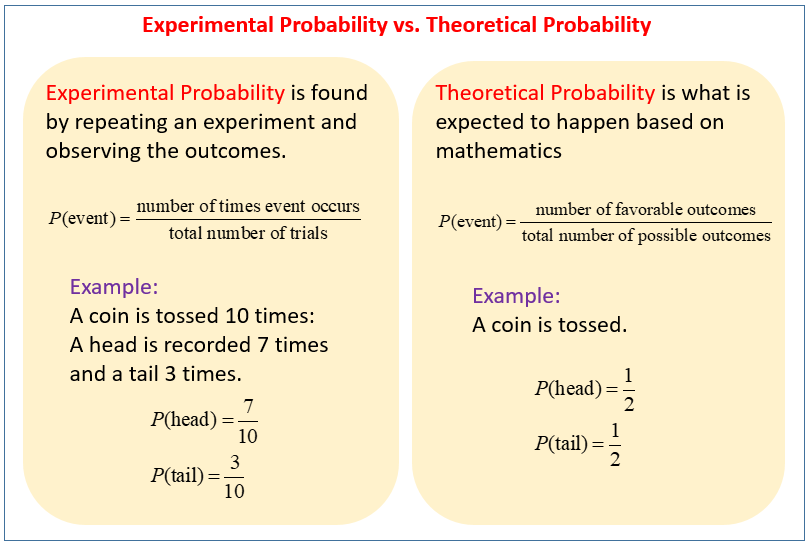Theoretical Probability & Experimental Probability
Related Pages
Probability Tree Diagrams
Probability Without Replacement
Probability Word Problems
More Lessons On Probability
In these lessons, we will look into experimental probability and theoretical probability.
The following table highlights the difference between Experimental Probability and Theoretical Probability. Scroll down the page for more examples and solutions.

-
Probability Worksheets
Printable
Probability (Equally Likely Outcomes)
Probability (Not Equally Likely Outcomes)
Probability Tree DiagramsOnline
Probability Problems
Complementary Probability
Probability Problems
Probability & Geometry
Mutually Exclusive Probability
Independent Events Probability
Dependent Events Probability
How To Find The Experimental Probability Of An Event?
Step 1: Conduct an experiment and record the number of times the event occurs and the number of times the activity is performed.
Step 2: Divide the two numbers to obtain the Experimental Probability.
How To Find The Theoretical Probability Of An Event?
The Theoretical Probability of an event is the number of ways the event can occur (favorable outcomes) divided by the number of total outcomes.
What Is The Theoretical Probability Formula?
The formula for theoretical probability of an event is
![]()
Experimental Probability
One way to find the probability of an event is to conduct an experiment.
Example:
A bag contains 10 red marbles, 8 blue marbles and 2 yellow marbles. Find the experimental
probability of getting a blue marble.
Solution:
Take a marble from the bag.
Record the color and return the marble.
Repeat a few times (maybe 10 times).
Count the number of times a blue marble was picked (Suppose it is 6).
The experimental probability of getting a blue marble from the bag is
![]()
How to find and use experimental probability?
The following video gives another example of experimental probability.
How the results of the experimental probability may approach the theoretical probability?
Example:
The spinner below shows 10 equally sized slices. Heather spun 50 times and got the following results.
a) From Heather’s’ results, compute the experimental probability of landing on yellow.
b) Assuming that the spinner is fair, compute the theoretical probability of landing in yellow.
Theoretical Probability
We can also find the theoretical probability of an event.
Example:
A bag contains 10 red marbles, 8 blue marbles and 2 yellow marbles. Find the theoretical
probability of getting a blue marble.
Solution:
There are 8 blue marbles. Therefore, the number of favorable outcomes = 8.
There are a total of 20 marbles. Therefore, the number of total outcomes = 20
Example:
Find the probability of rolling an even number when you roll a die containing the numbers 1-6.
Express the probability as a fraction, decimal, ratio and percent.
Solution:
The possible even numbers are 2, 4, 6.
Number of favorable outcomes = 3.
Total number of outcomes = 6
The probability = ![]() (fraction) = 0.5 (decimal) = 1:2 (ratio) = 50% (percent)
(fraction) = 0.5 (decimal) = 1:2 (ratio) = 50% (percent)
Comparing Theoretical And Experimental Probability
The following video gives an example of theoretical and experimental probability.
Example:
According to theoretical probability, how many times can we expect to land on each
color in a spinner, if we take 16 spins?
Conduct the experiment to get the experimental probability.
We will then compare the Theoretical Probability and the Experimental Probability.
The following video shows another example of how to find the theoretical probability of an event.
Examples:
-
A spinner is divided into eight equal sectors, numbered 1 through 8.
a) What is the probability of spinning an odd numbers?
b) What is the probability of spinning a number divisible by 4?
b) What is the probability of spinning a number less than 3? -
A spinner is divided into eight equal sectors, numbered 1 through 8.
a) What is the probability of spinning a 2?
b) What is the probability of spinning a number from 1 to 4?
b) What is the probability of spinning a number divisible by 2?
Try out our new and fun Fraction Concoction Game.
Add and subtract fractions to make exciting fraction concoctions following a recipe. There are four levels of difficulty: Easy, medium, hard and insane. Practice the basics of fraction addition and subtraction or challenge yourself with the insane level.

We welcome your feedback, comments and questions about this site or page. Please submit your feedback or enquiries via our Feedback page.